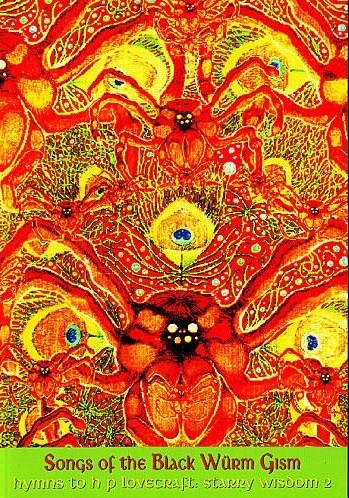In 1994, Creation published The Starry Wisdom, a collection of Lovecraft-inspired stories that remains the standard on how to take an author’s aesthetic and transplant it into different times and styles. Cyberpunk Lovecraft, beat Lovecraft, whatever. This isn’t an uncommon thing to try now (Nick Mamatas does it often), but at the time, it was almost revelatory. It was ambitious, far-reaching, and studded with big names (Ramsay Campbell, Alan Moore, JG Ballard) and classic stories.
In 2009, we got this Starry Wisdom Part 2: Featuring Worse Writers.
The book is shorter, and decidedly unstudded with big names. No Ballard. No Gira. Moore doesn’t contribute prose. Coulthart doesn’t contribute art. No Campbell or Burroughs. Whitechapel wrote a story, but it doesn’t appear here. At least we don’t have to read James Havoc’s girlfriend this time around, so thank fuck for that.
Instead, the material is written by guys from Creation and Savoy (Havoc, Britton, Mitchell…), with several obvious pen-names, and weird Japanese hentai crap. The results are uneven. Kenji Siratori doesn’t write a story so much as drop a bomb into the book, reducing clean virgin paper into a 5-page blast radius of sheer noise. Then there’s “visual art” by some guy called Wakamatsu Yukio. Japanese women covered in dead goldfish. Is that your thing? I confess it isn’t mine.
Black Wurm Gism has a talent problem, and also a value problem. Even with all the stupidity and filler, the book barely makes it to the 180 page mark. The Starry Wisdom was nearly forty pages longer, and had far more actual stories. Black Wurm Gism blows a lot of pages on odd surrealistic gestures.
The Starry Wisdom was dominated by conventional horror fiction, with a few experiments. Here the experiments dominate, with conventional horror fiction only briefly appearing like snatches of music emerging out of the atonal mess of an orchestra tuning up. DM Mitchell states that his intention was to steer Black Wurm Gism away from being a horror collection. He certainly succeeded – or failed, depending on your tastes. Personally, I would rather read JG Ballard than Kenji Siratori.
I liked the strange parts of Starry Wisdom, but Black Wurm Gism is obsessed with not making sense, and it leaves me cold. Why must everything be experimental and bizarre? Couldn’t they have included more than a few actual stories? If it’s an issue of content, what about William Hope Hodgeson…his work is now in the public domain now, isn’t it?
David Britton contributes a story from the Lord Horror universe. James Havoc co-writes a piece with “Herzan Chimera” (apparently comic artist Mike Philbin)…it’s funny seeing his prose straightjacketed into conventional style, like ape in a three piece suit. Otherwise it’s a steady trudge of obscurantist nobodies. Once the aforementioned fish-porn piece ends, we get the wonderfully titled but nearly unreadable “Machines Are Digging” by Reza Negarestani, a name I keep seeing in these kinds of books. He writes in a new genre called “theory fiction”, and it’s fairly clear why it’s a new genre.
If you liked the first book and want another fix, Songs of the Black Wurm Gism is what you’re looking for. But be warned: this time the china white has been cut with sawdust. It’s an inferior product, and I wish Mitchell had thrown Siratori and Negarestani and all the rest of these dickfucks away, kept the good stories, and released them in an updated version of Starry Wisdom. Horror collections live and die on the strength of their stories. Ten pages of naked women covered in fish is not a substitute.
No Comments »
Comments are moderated and may take up to 24 hours to appear.
No comments yet.

